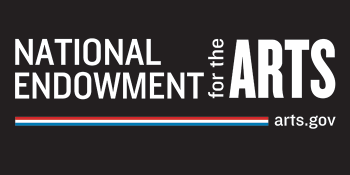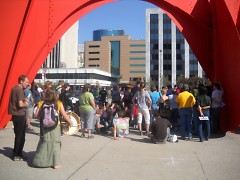The first few months of Occupy Wall Street saw a storm of media coverage, and the many offshoot groups to follow sparked no less controversy. While some saw the movement as representing a much needed change, still others felt that various occupations were simply a stage for young rabble rousers and revolutionaries to voice their complaints against the status quo. Indeed, media coverage of the Occupy phenomenon has often been less than flattering, frequently citing the movement’s lack of organization and clearly defined aims.
But which of these claims holds more water: revolutionary or unfocused? And what does the local movement, Occupy Grand Rapids (OGR), mean for this city? In order to portray what Occupy Grand Rapids is, it helps to begin with exactly how the group works. No less important is the group's demographics and overarching goals.
Attendance at any of OGR’s General Assemblies will reveal a group that is much more organized than one might initially expect. The group has its staging area at Fountain Street Church where occupiers hold General Assemblies on Wednesday evenings (6pm) and Sunday afternoons (2pm). They speak by order of a speaker's list called a stack. They vote for issues via hand signals. They plan upcoming protests and demonstrations, and all of this is done according to clearly defined procedural rules. Issues are handled democratically and voted upon at the beginning of meetings, giving all of OGR’s members a chance to speak their piece and determine what issues the group attends to.
As for OGR’s demographics, people from all races, backgrounds, and walks of life have participated in the movement. George Bartnick, age 56, worked as an accountant for the Bell corporation for several years before turning his back on business and teaching in a Yogi Ashram for seven years. Bartnick may not be the person you would picture holding up signs or chanting protests, but he represents the membership of OGR much more realistically than the general media stereotype. He isn't homeless or a student. He's no radical, but he believes in constitutional change and has become active in the local Move to Amend movement. He also wants health care reform and better access to education for all citizens - issues that many Americans would like to see addressed.
Still, OGR does have its share of students and radicals. Far closer to the kinds of people the media portrays as prevalent in the occupy movement are Mandi Creveling, 24, and Diane Baum, 62.
Creveling attends Grand Rapids Community College and sees sustainability as a major public issue. She helped start the Really Really Free Market, has worked with Willing Workers on Organic Farms and is one among a number of students that take part in OGR. Still, to say that OGR is primarily composed of students is a gross overstatement.
Diane Baum traces her activist roots all the way back to age 15, when she first started buying socialist magazines. She explored radical and alternative politics, protesting during the 60s and 70s. She believes that Occupy is really about non-class communication. Even while her unbridled enthusiasm for change, her eccentric and outgoing attitude, and her atypical thoughts on the future of the country may seem quite radical, her dedication to the democratic and philosophical principles of OGR tapers her more unique views.
But exactly what are the Occupy's principles? This question has been central to media criticisms of occupy movements around the country. To many, Occupy Wall Street and similar groups are assemblies of people unified by nothing more than their own dissatisfaction with the government.
While OGR can’t be said to have any clear cut goals, its members are unified on a number of key issues. Many believe that there is a need to hold corporations responsible for the recent financial crisis, to make them accountable for their actions. Still others call for an end to corporate campaign funding, sparking offshoot groups such as Move to Amend. Healthcare and tax reform aren’t far behind in importance, and the group certainly isn't wanting for its share of environmentalists.
It's not as if all of OGR's members agree on how these issues should be handled or even on how to prioritize them. Occupiers are most unified in respecting and promoting the philosophical principles that have founded and guided the movement. Democracy and freedom of speech shape the very structure of their meetings, and acts such as petitioning, protesting, and holding public events reinforce these ideals. Occupy is about giving the people the chance to voice concerns and affect change, and this shows in nearly everything its members do.
In the end, it’s difficult to define Occupy Grand Rapids in any concrete manner. Does it have its fair share of students and radicals? Certainly, but a large number of occupiers come from all walks of life and want legal and constitutionally backed change. Does OGR have a clear and well defined goal? No, but members are comfortable with this lack of a list, stating that clear cut goals would hamper the very spirit of the movement, which seeks to give its members a stage from which to voice their opinions on any and all public issues.
It’s safe to say that OGR represents the qualms of quite a few Americans: outrage at the financial crisis and the clemency granted to those responsible; disgust at national poverty levels and the increasing disparity between the rich and the poor; and most of all, the lack of political checks against corporate power, especially in influencing political decisions thanks to decisions such as the Supreme Court's Citizens United ruling in 2010. OGR and many other occupy movements, such as Occupy the Lake Shore, are about presenting these grievances to the corporations, to the politicians and to the people, and for that, they should be recognized as more than a ragtag group of students, radicals, and the unemployed.
The Rapidian, a program of the 501(c)3 nonprofit Community Media Center, relies on the community’s support to help cover the cost of training reporters and publishing content.
We need your help.
If each of our readers and content creators who values this community platform help support its creation and maintenance, The Rapidian can continue to educate and facilitate a conversation around issues for years to come.
Please support The Rapidian and make a contribution today.

